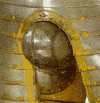The Quarter Presents
A "Brief" Introduction To The Codpiece!

Some experts say it was used to simply cover a man's privates when the hosen they were wearing evolved into a very snug fit and restricted movement. The hosen needed to be split in the front for comfort without sacrificing the tautness of the garment. It started out being very utilitarian as a small bag with a flap at the fork of the hose, closed by ties.
During the first half of the fifteenth century, England was ruled by two pious monarchs: Henry V and his son, Henry VI, who was even more pious. However, pious as Henry VI was, he was an incapable ruler and the result was the Wars of the Roses. In 1461, Henry VI lost his crown to Edward IV, alleged to be the handsomest man in Europe. Edward's younger brothers, George and Richard were pretty good-looking as well.

Well, what's a good looking monarch to do? Edward IV was well known for his amorous pursuit of the ladies, so it is not surprising that the fashion of the times, led by a lusty teenager, would focus on his "gifts." The Plantagenets were well known for their physical beauty and style, and that the codpiece style should befit a young and handsome king is not surprising. Virility, or at least the projection of that image, was important to monarchs during the early Renaissance, both in portraying an aura of strength to enemies and in presenting an image to the people that the succession would not be a problem. Edward IV wanted to present a robust and masculine image by wearing shorter doublets might very well be, and the use of a codpiece to show off his package was surely a guarantee for getting a date on Friday nights.
 |
| We've heard of "buns of steel", but this is ridiculous! |
In the fourteenth and fifteenth centuries, it was rendered prominent with padding. However, with the ascension of Elizabeth I, her influence in dress was more towards the ladies with her stern and strict silhouette. Maybe it was in being reminded of her obligation to provide an heir to the throne (remember - she was known as the "virgin" queen), such obvious flaunting of the male anatomy may have helped hasten the demise of the codpiece.
It was Henri III, king of France, who promptly killed off the fashion of the codpiece. Henri III, a homosexual, whose nature may or may not have influenced his ruling of France, had a marked effect on men's fashions. He had no use for such a masculine appendage and chose not to use it in his persona display. With the disappearance of the codpiece, the overall costume showed a tendency towards the feminization, accentuated by the small muffs carried and the earrings worn. How butch!
